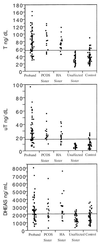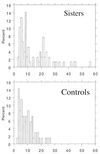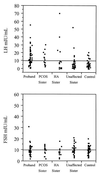Evidence for a genetic basis for hyperandrogenemia in polycystic ovary syndrome
- PMID: 9843997
- PMCID: PMC24557
- DOI: 10.1073/pnas.95.25.14956
Evidence for a genetic basis for hyperandrogenemia in polycystic ovary syndrome
Abstract
Our preliminary family studies have suggested that some female first-degree relatives of women with polycystic ovary syndrome (PCOS) have hyperandrogenemia per se. It was our hypothesis that this may be a genetic trait and thus could represent a phenotype suitable for linkage analysis. To investigate this hypothesis, we examined 115 sisters of 80 probands with PCOS from unrelated families. PCOS was diagnosed by the combination of elevated serum androgen levels and </=6 menses per year with the exclusion of secondary causes. The sisters were compared with 70 healthy age- and weight-comparable control women with regular menses, no clinical evidence of hyperandrogenemia, and normal glucose tolerance. Twenty-two percent of the sisters fulfilled diagnostic criteria for PCOS. In addition, 24% of the sisters had hyperandrogenemia and regular menstrual cycles. Circulating testosterone (T) and nonsex hormone-binding globulin-bound testosterone (uT) levels in both of these groups of sisters were significantly increased compared with unaffected sisters and control women (P < 0.0001 for both T and uT). Probands, sisters with PCOS, and hyperandrogenemic sisters had elevated serum luteinizing hormone levels compared with control women. We conclude that there is familial aggregation of hyperandrogenemia (with or without oligomenorrhea) in PCOS kindreds. In affected sisters, only one-half have oligomenorrhea and hyperandrogenemia characteristic of PCOS, whereas the remaining one-half have hyperandrogenemia per se. This familial aggregation of hyperandrogenemia in PCOS kindreds suggests that it is a genetic trait. We propose that hyperandrogenemia be used to assign affected status in linkage studies designed to identify PCOS genes.
Figures



References
-
- Legro R S, Spielman R, Urbanek M, Driscoll D, Strauss J S, Dunaif A. Recent Prog Horm Res. 1998;53:217–256. - PubMed
-
- Franks S, Gharani N, Waterworth D, Batty S, White D, Williamson R, McCarthy M. Hum Reprod. 1997;12:2641–2648. - PubMed
-
- Ferriman D, Purdie A W. Clin Endocrinol (Oxford) 1979;11:291–300. - PubMed
-
- Lunde O, Magnus P, Sandvik L, Hoglo S. Gynecol Obstet Invest. 1989;28:23–30. - PubMed
-
- Lander E S, Schork N J. Science. 1994;265:2037–2048. - PubMed
Publication types
MeSH terms
Grants and funding
LinkOut - more resources
Full Text Sources
Medical

